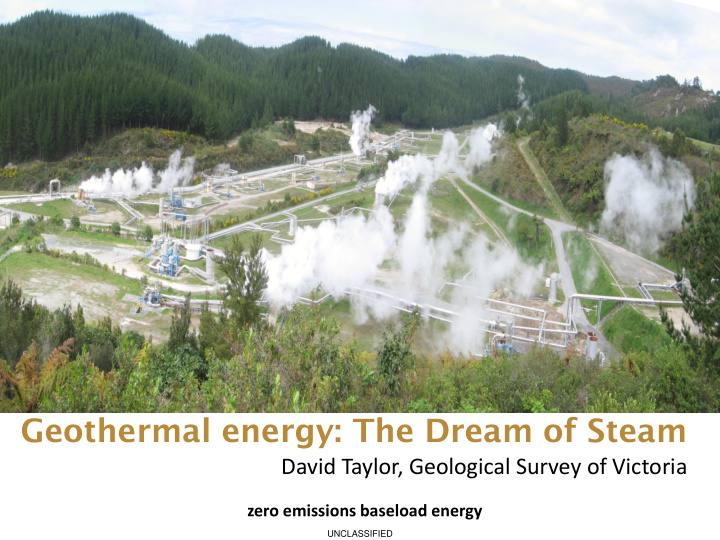



UNCLASSIFIED Geothermal energy: The Dream of Steam David Taylor, Geological Survey of Victoria zero emissions baseload energy UNCLASSIFIED
UNCLASSIFIED Geological Surveys UNCLASSIFIED
UNCLASSIFIED Geothermal is Greek for Hot Earth The deeper you go, the hotter it gets: 30C/km = 150C @ 5km* *150C is min commercial temperature and 5 km is max commercial drilling depth Therefore need better than average conditions for geothermal energy UNCLASSIFIED
UNCLASSIFIED World Geothermal Electricity output = 10,000 MW UNCLASSIFIED
UNCLASSIFIED At plate margins steam is bursting out of the ground = commerical UNCLASSIFIED
UNCLASSIFIED But wait!.....wasnt that a volcano I drove past on the way here? UNCLASSIFIED
UNCLASSIFIED Latest count 416 volcanoes: oldest is 7.8 Ma youngest 5000 years! Therefore eruptions on average every 18,000 years Source: Dr Julie Boyce Monash University 2013 UNCLASSIFIED
UNCLASSIFIED If magma chambers exist then blobs 1-2 km about 3-5 km depth Temperature C Magma body Host rocks Source: Dr Jim Cull ‘ GeoScience Australia’ 1979 UNCLASSIFIED
UNCLASSIFIED GeoGen Victoria/AGL drilled beneath big young volcanoes Thanks to advances in computing power it could also be possible to search for magma chambers using geophysical methods such as passive seismic listening posts or Magneto-telluric surveys UNCLASSIFIED
UNCLASSIFIED Laws of Physics means use shallow heat flow to predict deeper temperature rather than having to do expensive deep drilling Temperature Gradient x Conductivity = Heat flow drilling costs 300 m = $100,000+ 3000 m = $10,000,000+ ie. 10x deeper = 100x $$$ H 5 km 1 T 2 C C H T? UNCLASSIFIED
UNCLASSIFIED Temperature Gradient x Conductivity = Heat flow Gradient Berrook-1 Available Core Temperature Gradient (°C/km) 0 25 50 75 100 125 150 0 -50 -100 59 (4%) x 1.30 (7%) = 77 (11%) Duddo limestone -150 Depth (m) 55 (8%) x 1.30 (7%) = 66 (15%) -200 50 (7%) x 1.4 (10%) = 70 (17%) Olney mud Olney sand 69 (10%) -250 Olney mud -300 32 (7%) x 2.5 (12%) = 79 (19%) Warina sand 30 (4%) x 2.4 (8%) = 72 (12%) -350 Weighted Mean = 75 (9%) 15 20 25 30 35 40 Temperature (°C) UNCLASSIFIED
UNCLASSIFIED Latest map V14 77 S11 63 S9 47 V3 70 S7 47 Sa 64 Sm 60 Sm 75 G 97 S1 80 B 86 UNCLASSIFIED
UNCLASSIFIED If magma chambers exist then blobs 1-2 km about 3-5 km depth Temperature C Magma body Host rocks Temperature Gradient x Conductivity = Heat flow 1000C @ 5 km = 200C/km X (n = 90) 3.5 ± 1.0 = 500 - 700 - 900 300C @ 3 km = 100C/km X (n = 90) 3.5 ± 1.0 = 250 – 350 - 450 Observed heat flow only gets up to just over 100 which doesn’t demand volcanic source UNCLASSIFIED
UNCLASSIFIED Can model the heat flow with conductivity to get temperature volcanic heat? UNCLASSIFIED
UNCLASSIFIED Conclusions (loaded with uncertainty) Victoria basically has an ‘active’ volcanic province that may have geothermal potential The fact that the volcanoes are basalt (not andesite or granite) means that the necessary magma chambers for geothermal heat may not exist The first search by drilling and heat flow found no proof of good volcanic heat but the search was very sparse in its testing Different and much improved geophysical methods such as passive seismic listening posts or Magneto-telluric surveys could be used for searching UNCLASSIFIED
Recommend
More recommend